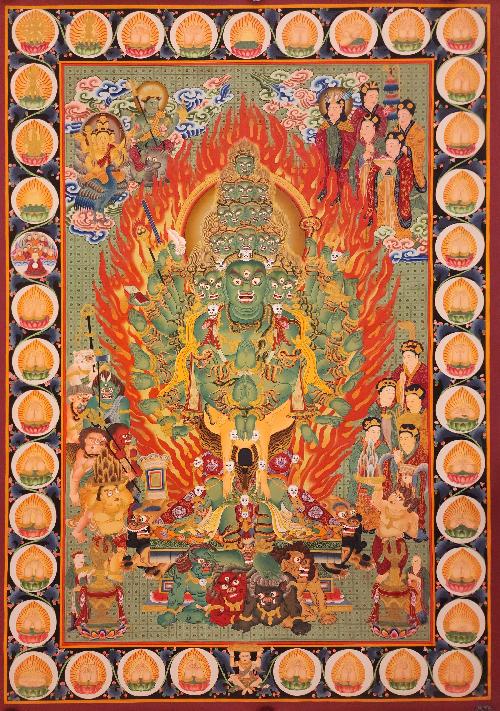Loading Content..

Acala or Achala (Sanskrit: अचल "Immovable") is a Dharmapala (protector of the Dharma), prominent in Vajrayana Buddhism and East Asian Buddhism. He is classed among the Wisdom Kings and is preeminent among the Five Wisdom Kings of the Womb Realm. Accordingly, his figure occupies an important hierarchical position in the Mandala of the Two Realms.
In China, he is known through esoteric Tangmi traditions as Budong Mingwang ("The Immovable Wisdom King"). In Japan, he is known as Fud? My??, which is the on'yomi reading of his Chinese name.He is also highly revered among some Yakuza members, who often draw on his intense facial expression and demeanor
Wooden sculpture of Acala. Japan, late Heian Period, 12th century
Wooden sculpture of Acala. Japan, late Heian Period, 12th century
Acala at Buddha Tooth Relic Temple and Museum, Singapore
Statue of Acala, from 12th century Japan. Currently in Rietberg Museum (Zürich,Switzerland)
Originally the Mahayana deity Acalanātha, whose name means "immovable protector", Acala was incorporated into Vajrayana Buddhism as a servant of the Buddha. In Tangmi (Tang-era Chinese Vajrayana), his name was translated as Budong "immovable" (Chinese: 不動; pinyin: Búdòng, Middle Chinese: /pǝw dungx/). In turn, the deity was imported into Japan as "Immovable" (不動, Fudō) by the priest Kūkai (died 835) who was studying in China as a member of the Kentoshi mission and founded Shingon Buddhism. Scholars such as Miyeko Murase state that the origins of this Buddhist deity are in the Hindu god Shiva, particularly his attributes of destruction and reincarnation.
The deity has been popular throughout the Middle Ages and into modern times in Nepal, Tibet, and Japan, where sculptural and pictorial representations of him are most often found. Much of the iconography comes from Japan.
In Tibetan Buddhism and art, the Buddha Akshobhya, whose name also means "the immovable one", presides over the clan of deities to which Ācala belongs. Other sources refer to the Acala and Caṇḍaroṣaṇa as an "emanation" of Akshobhya
He evolves into a deity invoked in Buddhist rituals to "frighten gods, titans, men and destroy the strength of demons", and he slays all ghosts and evil spirits. In some Buddhist texts such as the Sādhanamālā, the Hindu gods Vishnu, Shiva, Brahma, and Kandarpa (god of love) are said to be "wicked" because they cause endless rebirth, and these gods are terrified of Acala because he carries a rope to bind them. In other texts, such as the Mahāvairocana Sūtra, one dedicated to the Buddha is instructed to visualize the left foot of Acala on his head during meditation, to prevent obstacles in his reaching Prajñā .
In the Nepalese and Tibetan Buddhist traditions, Viśvavajrī becomes Acala's consort.
Loading..
Please wait for the page to fully load for optimal functionality.
Loading Content..